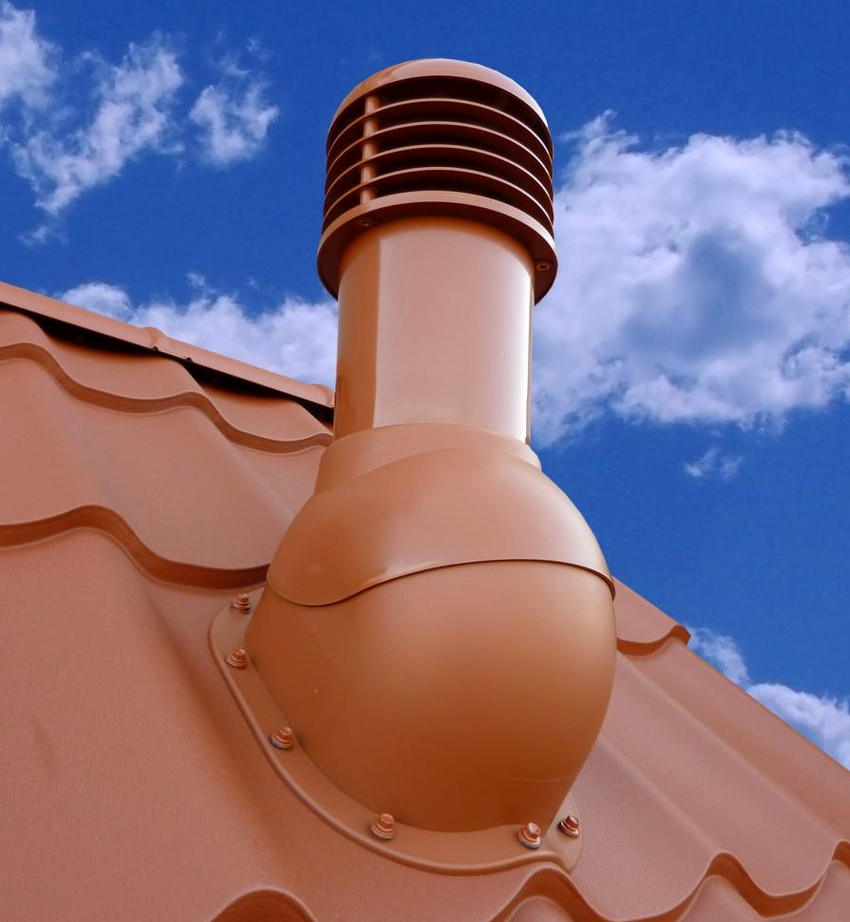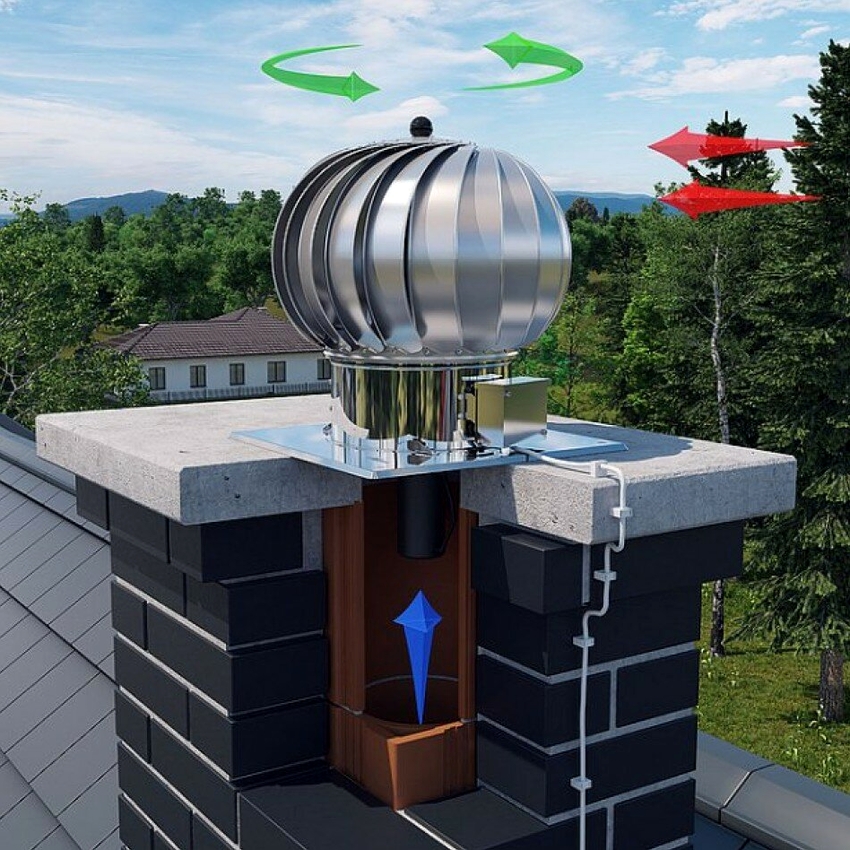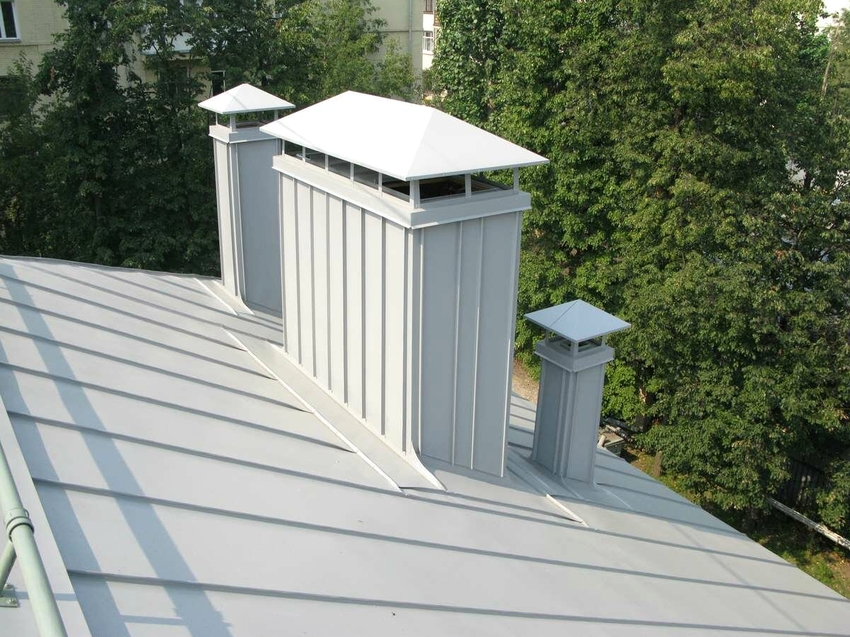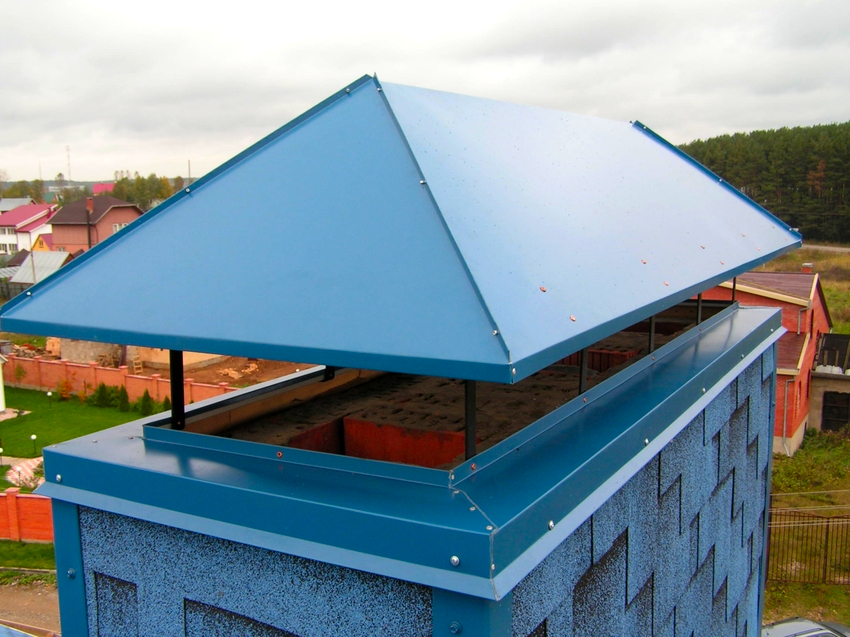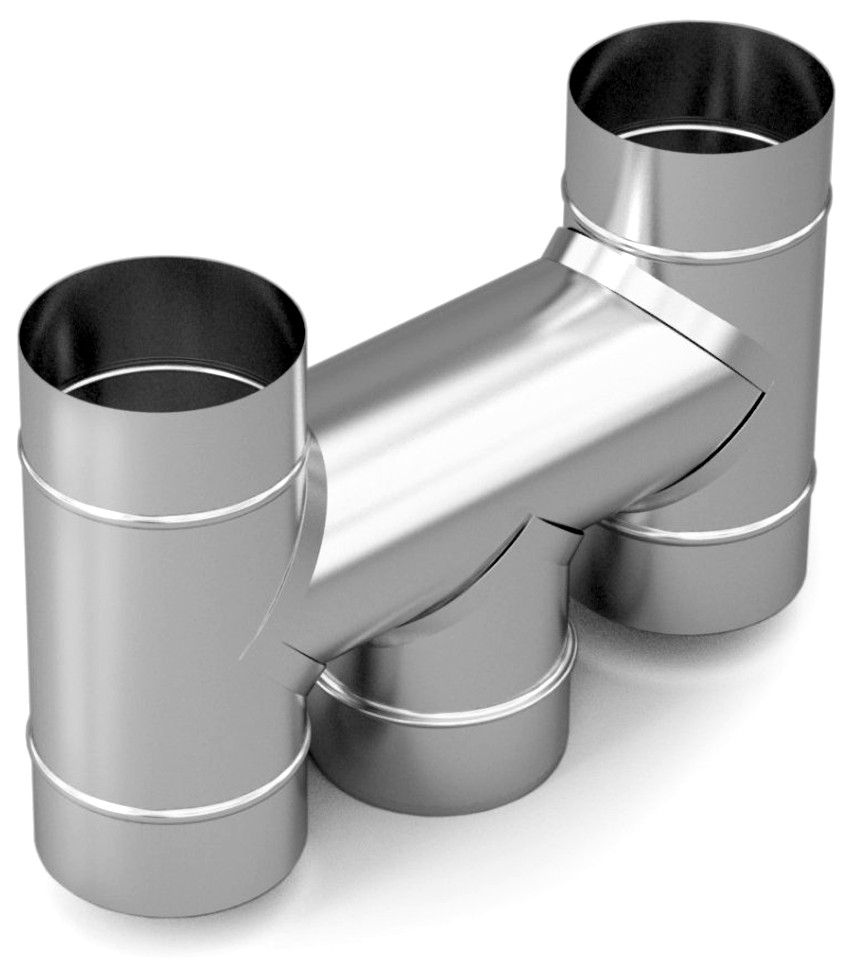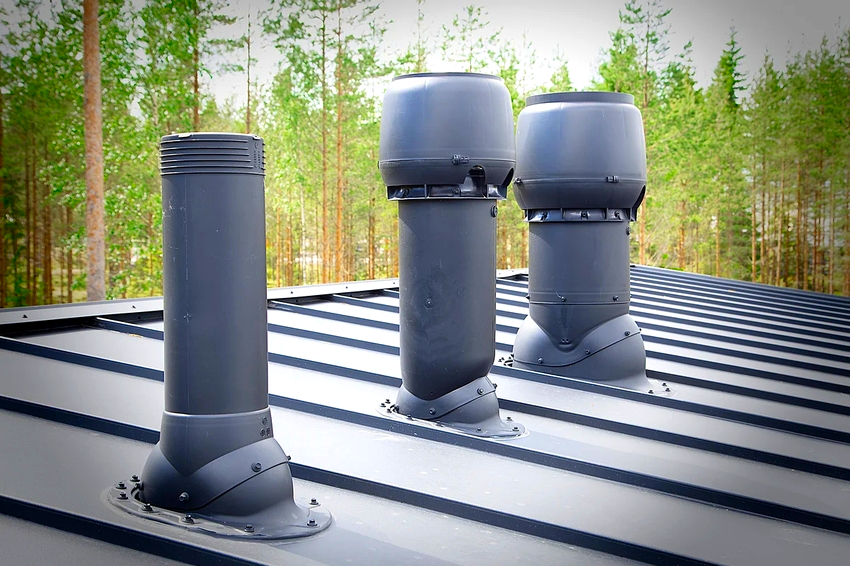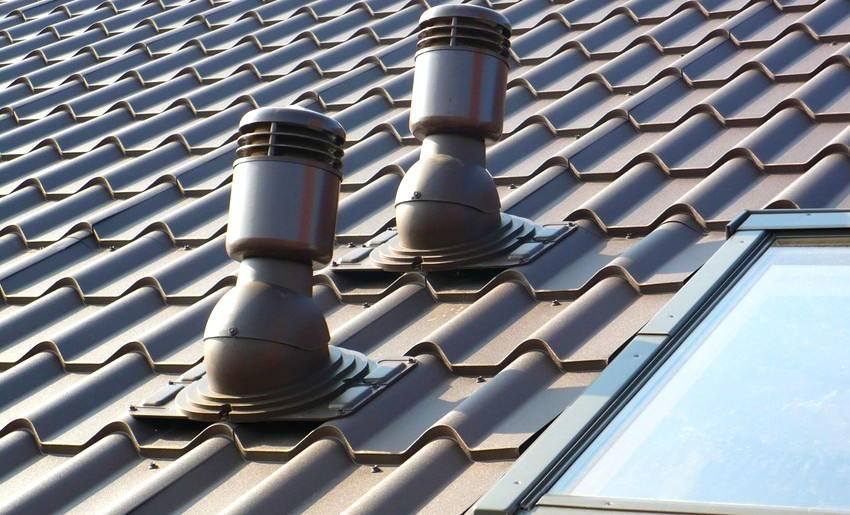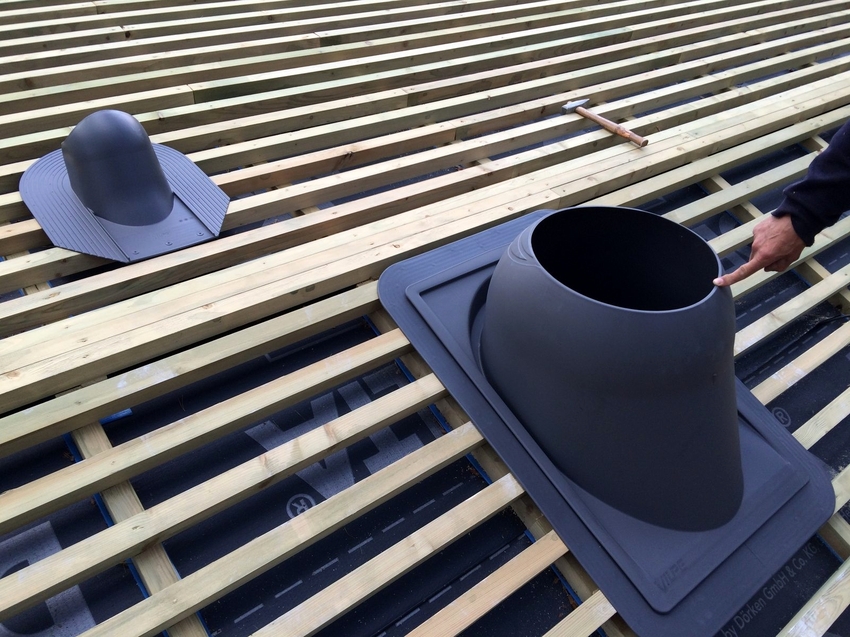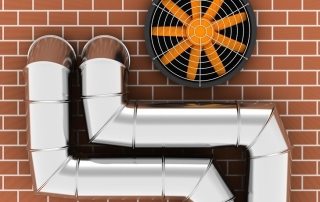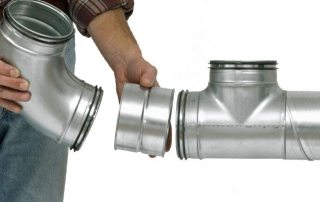In order for a person to be comfortable in the room, it is necessary to ensure normal air circulation. Continuous air exchange creates a properly organized ventilation system, but its efficiency depends on internal draft. If the ventilation duct is not protected, there is a risk that the structure will become clogged with debris and cease to function. To prevent the problem, a ventilation deflector is installed on the air duct.
Content [Hide]
- 1 Deflector: this is a really necessary element; what it consists of, what tasks it performs
- 2 Types and characteristics of deflectors for a pipe: the main differences
- 3 Deflector TsAGI and other design options
- 4 How to choose a ventilation deflector: what to focus on
- 5 Features of the installation of the device and useful tips for correct installation
- 6 How to make TsAGI and a turbo deflector for ventilation with your own hands: drawings, stages of work
Deflector: this is a really necessary element; what it consists of, what tasks it performs
The effective operation of the ventilation system is primarily influenced by the strength of the wind, its direction, as well as the air temperature. For example, in summer it is very hot outside, and due to the fact that the air heats up, the draft decreases and, accordingly, the air circulation is reduced. To reduce the impact of such negative influences, devices such as deflectors are installed. The use of structures is considered mandatory when organizing a chimney, because a deflector is primarily a device that normalizes the operation of a ventilation system.
Fact! To understand what a deflector is, refer to the images of the outlets of the ventilation pipes. It is the dome, ball or any other structure located on the roof that is the deflector. The main task of the device is to ensure normal ventilation of various kinds of premises by using wind loads.
By and large, the deflector is a fairly simple device that was previously used only when equipping chimneys, and now it is the crown of the ventilation system. At the same time, one should not think that the only role of the device is protective.
In fact, deflectors are aerodynamic devices that reduce the negative impact of weather factors on ventilation. It functions according to the Bernoulli effect principle.The main task of ventilation deflectors is to provide better traction within the system by regulating the air flow.
That is why the devices are installed at the highest point of the pipe. Gadgets can be seen in most garages, which are topped with pipes emanating from basements or basements. In addition, deflectors are located almost everywhere on rooftops.
Why install a deflector on the chimney, what are its main functions
As already noted, after installing the air duct deflector, the thrust increases significantly. This is because the structure deflects the air flows and forms a zone of reduced pressure at the outlet of the ventilation. It is for this reason that the air masses inside rise through the pipe and compensate for the lack of pressure.
On trading floors, you can find a large number of design varieties, but, despite this, they all work on a similar principle. Some manufacturers produce deflectors with narrowed channels to increase the speed of air passage over the pipe head. In this case, the "airbrush principle" is triggered, and the action of the traction becomes several times greater.
Choosing the right air deflector can significantly increase ventilation efficiency. Sometimes productivity is increased by 20%. Devices installed on ventilation ducts, characterized by a large number of horizontal and winding sections, work best.
The main task performed by the deflectors installed on the roof is considered to be the shelter of ventilation ducts from the penetration of contaminants, as well as birds and other living creatures from the outside. Even in a short time, small debris, fallen leaves, dust and other particles accumulate on the walls of the pipe, thereby leading to a narrowing of its diameter. For these reasons, the entire system can fail. Other instrument functions:
- protection against atmospheric precipitation;
- increased traction;
- increasing ventilation efficiency up to 20%;
- extinguishing sparks and ensuring fire safety;
- preventing the appearance of a reverse draft, the so-called overturning effect of ventilation.
What elements does a deflector consist of, what is a ventilation diffuser
To better understand how the deflectors of ventilation systems work, you need to know what the structure consists of and what the device circuit looks like. So, the main components of the ventilation attachment are:
- Diffuser. It is a cone-shaped base with a truncated bottom. The lower fragment of the cylindrical flask is attached to the upper part of the ventilation duct that opens onto the roof, which results in a slowdown in the air flow and an increase in pressure.
- Umbrella. Detail preventing debris from entering the ventilation duct. It looks like a protective cover attached to the top of the diffuser.
- Housing. Visible detail of the deflector. It is represented by a shell or rings that are connected to the diffuser using two or three brackets. Precisely because the elements of the body cut the air flow, a reduced pressure is formed inside the cylindrical flask.
To prevent precipitation from entering the system, the diameter of the diffuser must be larger than the size of the inlet. The housing is installed in such a way that the air creates the so-called suction through the recesses of the adjacent rings. In this case, it will be possible to accelerate the removal of air masses from the ventilation system.
It is interesting! The ventilation deflector is designed in such a way that the air currents that rise from the bottom up are reflected from the roof, and then begin to fall again.Most often, this happens when the wind is blowing from below. If such a problem is present, it is better to install a two-cone structure, where the elements are connected by one base.
It should also be understood that if there is a side wind outside, then the air flow will come out through the lower and upper parts. With a vertical wind direction, only air outflow from below will be present. In short, the principle of operation of the deflector installed on the hood looks like this:
- wind streams are captured by the device;
- the air flow enters the diffuser, forks and leads to the fact that the pressure in the upper part of the channel decreases;
- the exhaust air from the room rushes upward - to where the discharged void has formed, and is discharged into the street.
If you choose the right size of the deflector and correctly install the structure on the upper part of the exhaust duct, the pressure difference will be optimal, as a result of which the rate of air exchange is normalized.
Types and characteristics of deflectors for a pipe: the main differences
If you look at the photo of the deflectors, you will notice that they all look different, but nevertheless they perform the same functions. Therefore, before giving preference to one of the models, you should pay attention to the following criteria:
- material of manufacture;
- operating principle;
- design features.
Basically, all models are made from the following materials:
- aluminum;
- of stainless steel;
- galvanized;
- copper;
- plastic;
- ceramics.
Checked! Ventilation experts believe that deflectors made of steel or aluminum are optimal in terms of price / quality ratio. Copper devices are also good, but due to the high cost, they are rarely used.
Devices are divided into the following types:
- TsAGI, characterized by the presence of a ventakal expansion - a diffuser;
- Volper cylindrical ventilation fungus;
- cap-weathervane, in the common people - "toady";
- H-shaped pipe deflector;
- turbo-reflector, which is a spherical rotary nozzle;
- open-type static-dynamic device Astato.
Some also include the regular umbrellas at the top of the canal. It should be understood that such devices only help to cover the ventilation from rain, but do not in any way affect traction.
Open structures also differ in shape, the following devices are considered the main ones:
- flat;
- semicircular;
- with opening lid;
- gable.
In addition to the fact that the devices are divided by the type of weather vane, they are also classified according to the principle of operation:
- rotary;
- deflector;
- turbine.
Chimney deflectors are primarily installed in order to improve draft, which removes smoke and carbon monoxide outside. In addition, after the installation of the device, heat transfer increases, and the fuel burns out better. Various photos of deflectors on the chimney also make it clear that with the help of the device, the pipe is protected from precipitation and other debris brought from outside.
Deflectors for the air conditioner, which in appearance differ from conventional devices, can be distinguished into a separate group. This design is a reflector screen that redistributes the air flow. As a result, the bundle of cool air is not directed directly, but parallel to the ceiling. Despite the fact that the air is dissipated, the pressure does not change from this.
Deflector TsAGI and other design options
The basement deflector is primarily intended for ventilation of basements and lower floors.After installation, not only the circulation of fresh air is established, but excess moisture from the surfaces also evaporates. It is considered convenient that the devices can be mounted in the case of both forced and natural ventilation.
In addition, the advantage of the deflector is that it protects basements and basements from the penetration of rodents and other small pests, as well as from precipitation. When installing, it is better to take a pipe with a margin in length, because it can always be reduced to the desired height, but it will not work to grow.
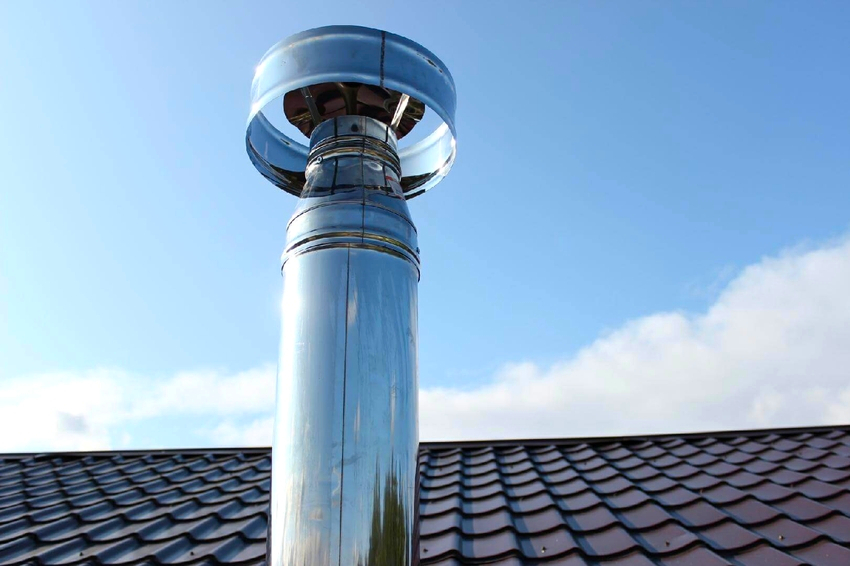
The TsAGI deflector consists of a glass, a cylindrical body, an umbrella-shaped cover and mounting posts
The design of TsAGI was developed back in the days of the Soviet Union and is still being successfully used. If you refer to the drawing of the TsAGI deflector, you can see that it consists of the following elements:
- a glass located at the bottom of the structure with an extension at the end;
- a cylindrical body, represented by a shell made of steel;
- umbrella-shaped cover;
- fastening posts made of metal strips.
The principle of operation is as follows: due to the blowing of the housing, a rarefied zone is created, located above the open diffuser. The exhaust air, mixed with carbon monoxide and other components, rises through the duct to the area of the formed low pressure zone and goes out. Here it is picked up by the wind and completely removed.
Important! The performance of the roof vent depends on the resistance of the duct system crossing the roof. The actual volume of the device is determined by the height of the pipe extension. The indicator is also affected by the temperature difference between indoor and outdoor air.
Despite the fact that the TsAGI device was developed a long time ago, it is still considered the best ventilation deflector for increasing traction. The high rating of the device is due to a large number of advantages:
- providing maximum protection against the penetration of precipitation;
- preventing the thrust from overturning, that is, drawing exhaust air back into the system;
- lack of dynamic details;
- reliability;
- the minimum coefficient of resistance, which does not exceed 0.6.
Among the advantages is the fact that it is quite easy to make a TsAGI deflector with your own hands. And most importantly, the productivity of the installation is completely unaffected by wind currents, although it should be noted that the device does not work effectively at low wind speeds. So, if the external air flow moves at a speed of less than 2 m / s, the efficiency of the deflector tends to zero. In fairness, it should be noted that in calm weather, most of these devices do not work well.
Related article:
Roof aerator: durable, reliable and efficient ventilation device
General characteristics of the device, advantages, principle of operation, installation and independent manufacture of the device, an overview of popular models.
Over time, the design of the device has nevertheless improved, because in the manufacture of the latest production models, the lower glass was insulated (in those cases when the cap was mounted to a sandwich pipe on the roof).
Other variants of ventilation deflectors series 5.904 51
Volper's static umbrella is more of a wind deflector than a traction enhancer. Despite this, the nozzle successfully compensates for the pressure loss at the outlet of the stream. According to the drawings, the structures consist of the following elements:
- lower glass or branch pipe;
- the upper glass of cylindrical shape, characterized by concave walls;
- umbrella in the form of a cone;
- connecting strips.
The nozzle is mounted on an air duct with a circular cross-section, and in the presence of a rectangular shaft, a special adapter is used. How Volper's umbrella works:
- Direct wind streams are reflected up and down due to the concave surface of the upper shell.
- Air masses, which pass between the umbrella and the plane of the glass cut, form a low pressure region inside the nozzle.
- The air from the hood changes the direction of movement, that is, it leaves through the gap located under the "fungus".
In terms of efficiency, the Volper umbrella is significantly inferior to the work of the TsAGI deflector, but at the same time it more reliably protects the air duct from sudden gusts of wind. Because it is technically difficult to make an exhaust umbrella with a curved glass with your own hands, many simplify the design and give it the shape of a cone. To increase productivity, a similar glass is installed in a mirror image, which is placed under the umbrella.
The H-shaped deflector is presented as a tube assembly and has the shape of the letter "H". In this case, the hood is connected to the middle part of the crossbar. After installing such a structure, it does not matter from which side the wind blows into the open pipe, because the flow in any case will eject, it is easier to say, entrain the flow of polluted air from the ventilation riser.
Among the advantages of a deflector for an H-shaped ventilation pipe are:
- almost 100% protection against wind ingress;
- prevention of reverse thrust effect;
- no possibility of moisture penetration or freezing of the system.
In addition to the advantages, there are also disadvantages of installing the nozzle:
- Violation of aerodynamics. To go out into the street, the exhaust air flow needs to overcome 2 turns located at an angle of 90 degrees. Despite the fact that the wind flow compensates for this deficiency, the traction force still increases minimally, due to which the extraction performance decreases.
- Large construction size. Due to the fact that the device is quite cumbersome, difficulties may arise during the installation process.
- Not too good looking. The volumetric structure brought out to the roof is characterized by the presence of 2-3 channels that crown such caps, which may look strange from a distance.
Useful advice! To assemble a ventilation deflector with your own hands, you will need to take several ready-made tees and connect them together. Such a device is suitable for ventilation of both a bath and a warm barn.
What are turbo deflectors and weather vane
The designs can be safely combined into one group, because they are not only similar to each other, but also have a similar principle of operation. If we consider the drawings of turbo deflectors, you can pay attention to the fact that a distinctive feature of the devices is the spherical shape of rotary devices with blades in the form of semicircles, which rotate under the influence of wind force. In this case, rarefied air, which increases the efficiency of the hood, is formed inside the sphere above the pipe head.
The productivity of the weather vane is ensured by the fact that the blades of the device always turn with their "backs" to the wind, thereby preventing the ingress of air flows into the channel. A low pressure zone is formed behind the structure body, the so-called aerodynamic shadow, which facilitates the rapid removal of polluted air from the vertical channel.
Among the advantages of a ventilation turbo deflector are:
- protection of the ventilation duct from overheating in summer, which allows you to reduce the cost of cooling the room on hot days;
- prevention of condensation formation under the roof by regulating the temperature in the heat;
- no need to connect the device to the electrical network;
- ensuring efficient operation, because the productivity of the turbo-reflector in some cases is 200% higher than that of static models.
In addition, the fact that the attachment has an attractive appearance can be separately noted. Unlike other models, the device looks like an elegant ball-shaped hood. After installing the deflector, excess heat, moisture, fine dirt and carbon monoxide vapors are independently drawn from the mine and the roof space. This increases the useful life of important building elements.
Before purchasing a ventilation turbo deflector, you should also familiarize yourself with the main negative aspects of the device:
- if there is no wind outside, the blades of the structure will not rotate and, accordingly, the thrust will not improve;
- deflector rotation units require constant maintenance, at least regular lubrication;
- if not noticed in time, complete or partial frosting of the nozzle is possible;
- design features do not allow the device to reliably protect the ventilation from the penetration of precipitation, especially on windy days;
- in strong winds, there is a possibility that the jammed weather vane will lose its integrity.
The relative disadvantages include the fact that the price of dynamic type deflectors is higher than the cost of static models. For example, the cost of umbrellas and deflectors of ventilation systems 5.904 51 does not exceed $ 20-30, while turbo deflectors can be purchased for at least $ 35-40, while the equipment requires constant maintenance.
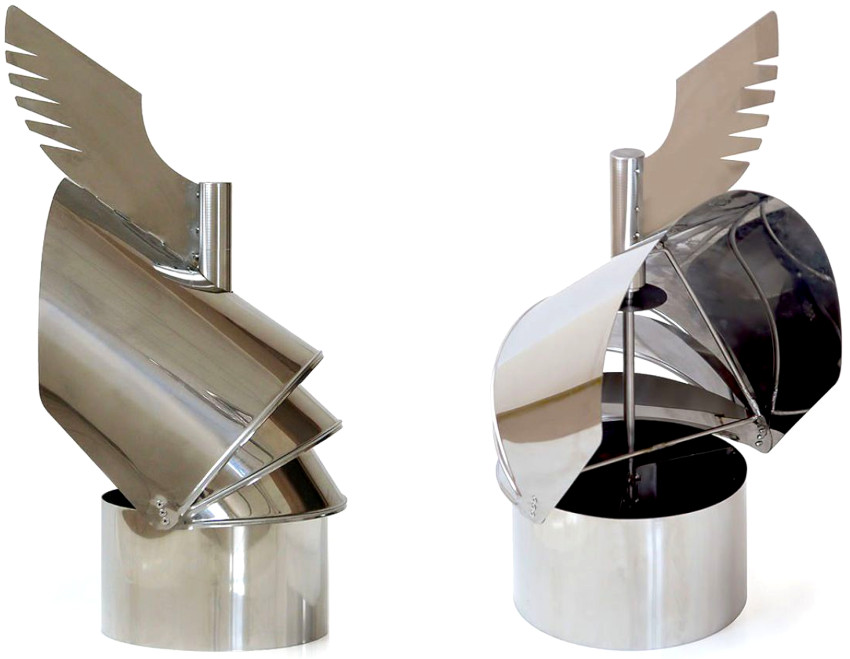
The productivity of the weather vane is provided by the blades, which always turn the device "back" to the wind
What is the Astato roof ventilation deflector
An important advantage of the deflector is productive work in any weather, even when there is no wind at all. If you study the drawings of the deflector, then you can pay attention to the fact that the structure is a nozzle made of two truncated cones, which are turned tops towards each other. On the top of the device there is an umbrella and an axial electric fan. The side opening is closed from birds and other animals with an aluminum mesh. Among the features of the device, the following points stand out:
- In strong winds, the nozzle acts as a static amplifier. Even when the fan is off, the exhaust air flow passing between the mirror-mounted cones is picked up by the street air and removed.
- In calm weather or in low wind conditions, a pressure sensor, the so-called pressure switch, is automatically triggered, which transmits a signal to the EOL control unit. After that, the controller activates the fan, forced removal of polluted air from the mine begins.
It is interesting! The controller response threshold is determined and adjusted by the user independently. A universal static-dynamic deflector can be triggered without expensive automation, because the function of switching on manually or from a temperature relay is available.
A significant disadvantage is the high price of a ventilation deflector: even a nozzle with a minimum diameter of 16 cm will cost the user 1300-1400 euros. If you want the device to automatically respond to changes in the ambient air, you need to add to this price the cost of the EOL unit, which is 1520 euros.
How to choose a ventilation deflector: what to focus on
If you need to choose a traction amplifier with minimal financial costs and not think about additional maintenance, you should opt for static deflectors: it can be a Volper cap or a TsAGI nozzle.The main advantage of the second option is that it is quite simple to construct such a deflector with your own hands.
Basic recommendations for choosing a forced draft device:
- If there is a lack of thrust, it is better to choose dynamic models of hoods - this can be a rotary deflector or a weather vane.
- There is no need to save money when buying a rotating blade design. In cheap models, there is often an installed open hinge that will freeze in winter. When choosing a turbo deflector or a weather vane, make sure that the bearing is closed.
- If the amplifier is planned to be installed in an area with predominantly windy weather, the H-shaped nozzle is recommended. If, on the contrary, the weather is often calm, the option of choice is the TsAGI deflector.
- The Astato nozzle, although it works in all weather conditions, requires regular maintenance. And this despite the fact that the cost of construction is very high.
Features of the installation of the device and useful tips for correct installation
To correctly calculate the deflector, you need to measure the diameter of the exhaust shaft. If there is a rectangular exhaust duct, you should choose a device with a circular cross-section, the value of which is equivalent to the size of the duct. That is, you need to calculate the cross-section of a rectangle and take a circle with a similar area. It should also be remembered that in this case, for installation, you will need to additionally use an adapter.
As for the installation of the deflector, here they are guided by the norms of SNIP, which regulate the installation rules. So, first of all, you need to pay attention to the height of the ventilation pipe and the hood, which is determined depending on the location on the roof:
- Height 50 cm, if the duct is located closer than 1.5 meters from the edge of the roof.
- Flush with the ridge or slightly higher when the distance from the parapet to the ventilation shaft varies from 1.5 to 3 meters.
- If the pipe is removed by more than 3 meters, the height is selected so that the top of the deflector is not lower than the deflection line drawn from the ridge down to the edge of the roof at an angle of 10 °.
Important! If the building has a flat roof, the device is installed at a height of at least 50 cm.
Additional points to consider during installation:
- Do not mount the deflector in an area covered by the aerodynamic shadow of other buildings.
- The device should be installed where there is free airflow. It is best when the hood is the highest point of the roof.
When organizing the ventilation system, one should also not forget about how to properly install the ventilation grill - up or down. Most craftsmen focus on the fact that in the presence of forced ventilation one way or another, air will enter the mine, so when installing it is better to focus on how the wall will look after installation and whether the grille slots will be conspicuous.
How to make TsAGI and a turbo deflector for ventilation with your own hands: drawings, stages of work
The turbo deflector has a rather complex design, so not many people undertake to manufacture the device on their own. If, nevertheless, it was decided to perform just such a design, you need to take care of the availability of the following tools and materials:
- sheet of stainless or galvanized steel;
- electric or cordless drill;
- ordinary and scissors for metal;
- bolts, screws, nuts and clamps;
- items for drawing design: ruler, pencil, compasses, cardboard and graph paper;
- welding machine.
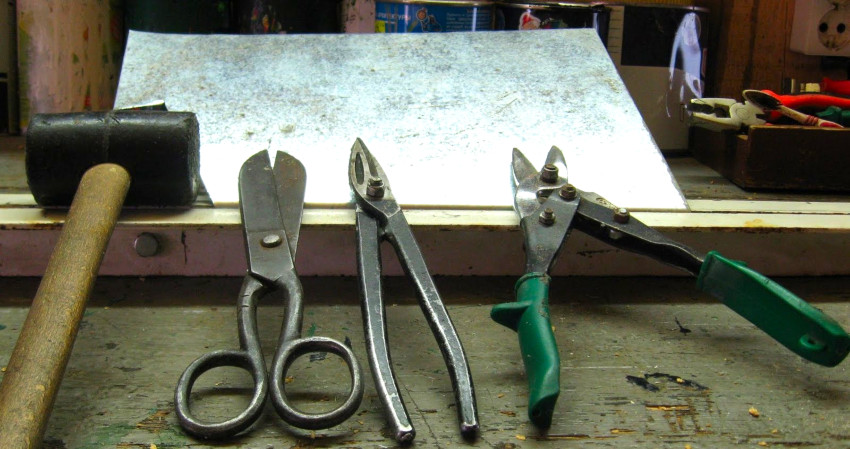
When self-manufacturing a TsAGI deflector, you will need: a mallet, a drill, a vice and metal scissors
When self-manufacturing, it is important to correctly complete the landing part, which will correspond to the desired pipe diameter. After that, plates are welded to the finished part with a tube located in the middle, into which the dynamic part of the device is inserted. Then, steel blades are formed according to the finished template, which are attached to the structure and form a turbo deflector. To understand how the execution process goes, it is better to refer to the videos available on the web.
Most craftsmen prefer to make a TsAGI device at home, because making a deflector is quite simple. To do this, you need to take galvanized steel no thinner than 0.5 mm, from which the necessary parts are then cut out. Rivets, bolts and nuts are used to assemble the structure. To work, you will need the following tools:
- hammer or mallet;
- drill;
- vice;
- scissors for metal;
- tape measure and pencil.
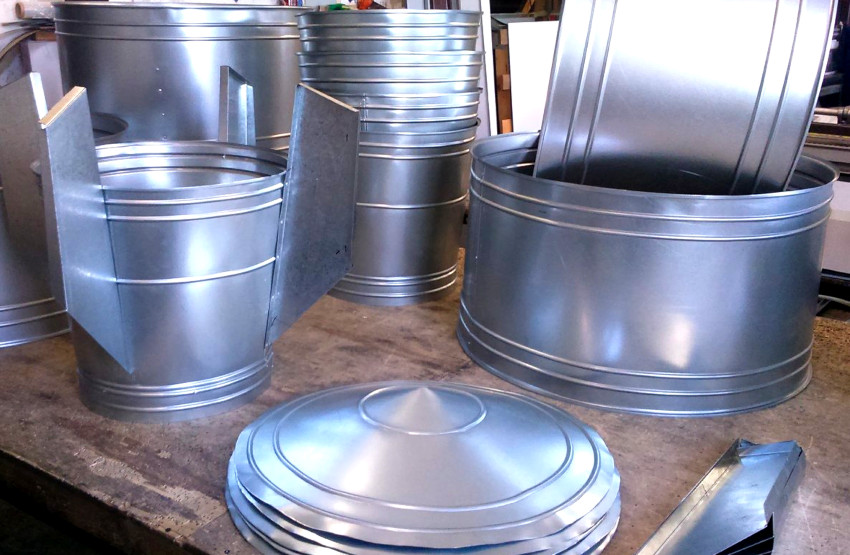
After cutting out the necessary parts from the sheets of tin, they are connected to each other using rivets
Due to the fact that a large number of ready-made drawings are available on the network, it will not be difficult for anyone to draw a diffuser. The main thing is to correctly determine the size. The most popular parameters are ventilation ducts with a diameter of 10-11 cm, especially if the hood is made of a plastic pipe.
So, after the necessary parts are cut out of the sheets of tin, they are connected to each other by means of rivets. Then the finished deflector is put on the head, and the lower branch pipe is pulled together with a clamp. If the shaft is square, an adapter is additionally manufactured or purchased, the flange of which is fixed to the end of the pipe.
Properly designed ventilation will help maintain a normal microclimate in the home, and a deflector installed on the roof will provide traction, which quickly clears the room of exhaust air. Despite the fact that most of the appliance models are not very expensive, they still guarantee a productive hood and preserve the health of residents.

